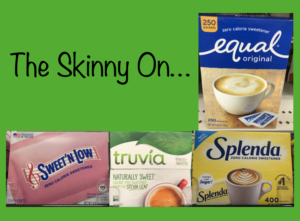 We have all heard about the dangers of artificial sweeteners…
We have all heard about the dangers of artificial sweeteners…
…from causing cancer, to disturbing the beneficial bacteria in our guts. So, it’s easy to see how we can become exasperated by all the conflicting and confusing messages.
Good news!
Not all calorie-free sugar replacers have negative stat sheets! Yes, according to the Center for Science in the Public Interest (CSPI), there are several sugar replacers we should avoid. However, there are others (albeit very limited) that come from natural sources and, even after necessary processing, appear safe to use in moderation. What a relief — especially during the holidays (prime baking season), when it is particularly difficult to stay below the recommended 6-9 teaspoons of added sugar per day.
NOTE: Since sources for information can be widely biased, our recommendations lean entirely upon the CSPI, which is a non-partisan watch-dog group that accepts no advertising dollars from any interest group…just honest reporting of the available science. CSPI provides a comprehensive chart online called “Chemical Cuisine”…feel free to check it out here for “the rest of the story.”
SUGAR REPLACERS TO AVOID:
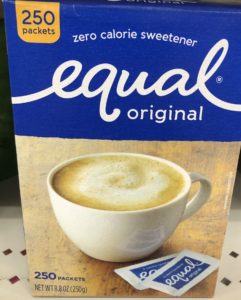 THE BLUE PACKET: Aspartame (NutraSweet, Equal or AminoSweet)
THE BLUE PACKET: Aspartame (NutraSweet, Equal or AminoSweet)
Often used in: soft drinks, drink mixes, gelatin desserts, frozen desserts, jams and fruit spreads, yogurt, breakfast cereal, candy, chewing gum, and other condiments.
What it is: a chemical combination of two amino acids and methanol.
Health concerns: Questions of neurological problems, such as dizziness or hallucinations, followed by studies linking it to cancer, and pre-term delivery of babies…there’s justifiable concern about aspartame. We summarize by quoting CSPI: “The bottom line is that three independent studies have found that consumption of aspartame causes cancer in rodents, and one epidemiology study found evidence that aspartame increases the risk of cancer in men. That should be reason enough for the FDA and other governments to eliminate aspartame from the food supply. Meanwhile, consumers should read labels carefully and avoid this artificial sweetener (specifically pregnant women and children).”
Aspartame (NutraSweet) is NOT REAL FOOD.
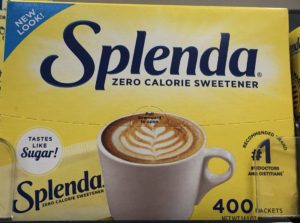 THE YELLOW PACKET: Sucralose (Splenda)
THE YELLOW PACKET: Sucralose (Splenda)
Often used in: baked goods, kettle corn, frozen desserts, ice cream, soft drinks, flavored waters and prepared meals.
What it is: a synthetic chemical made by chemically reacting sugar with chlorine, and is therefore no longer allowed to be marketed as “made from sugar.”
Health concerns: In 2016, an independent Italian laboratory published a large study on mice finding that sucralose caused leukemia and related blood cancers. Several researchers contend that sucralose negatively affects the gut, including changes in the microbiome and enzymes, which could have a range of consequences, including effects on blood sugar, regulation of body weight and inflammatory bowel disease. Even setting aside these concerns, young children could exceed the FDA’s “acceptable daily intake” for sucralose (5 mg/kg), especially given sucralose’s popularity (products containing sugar substitutes use sucralose more than any other sweetener). For example, a 6-year old child weighing 45 pounds would exceed the FDA limit by drinking two or three 12-ounce sodas containing the typical 40-60 mg of sucralose per can. In addition, sucralose passes into breast milk at levels high enough to make the milk sweeter.
Sucrolose (Splenda) is NOT REAL FOOD.
 THE PINK PACKET: Saccharin (Sweet ‘N Low) – “the original artificial sweetener”
THE PINK PACKET: Saccharin (Sweet ‘N Low) – “the original artificial sweetener”
Often used in: was used in a variety of processed foods, which have almost all been replaced with aspartame or sucralose, but still remains available in the “pink packet.”
What it is: chemical compound made by the oxidation of o-toluenesulfonamide, as well as from phthalic anhydride (as if that makes any sense…but doesn’t sound natural, does it?!)
Health concerns: discovered accidentally in 1879, many studies on rodents have shown that saccharin can cause cancer of the bladder, uterus, ovaries, skin, blood vessels, and other organs. Additional studies have shown that saccharin increases the potency of other cancer-causing chemicals; however, other animal and human studies did not identify a cancer risk. The FDA proposed that saccharin be banned. However, Congress intervened and permitted it to be used, provided that foods carried a warning notice. In 1997, the diet-food industry began pressuring the U.S. and Canadian governments and the World Health Organization to take saccharin off their lists of cancer-causing chemicals and, by May 2000, succeeded. Later that year, Congress passed a law removing the warning notice. Saccharin is passed through into the breast milk of nursing mothers.
Saccharin is NOT REAL FOOD.
ACESULFAME-POTASSIUM
Often used in: while this one doesn’t have it’s own “colored packet,” manufacturers use it widely in soft drinks, drink mixes, baked goods, gelatin, frozen desserts, yogurt, candy and chewing gum.
What is it: also called ace-K (the K is the chemical symbol for potassium). It is often used together with sucralose or aspartame.
Health concerns: the CSPI strongly opposes this sugar replacer. The safety tests of ace-K were conducted in the 1970s and were of mediocre quality, and of short duration. Despite this, two rat studies suggested that the additive might cause cancer. In addition, large doses of acetoacetamide, a breakdown product of ace-K, have been shown to affect the thyroid in rats, rabbits and dogs. The CSPI’s opinion is that the FDA should require manufacturers to conduct high-quality, modern-day studies of acesulfame potassium or withdraw its approval.
“ACE K” is NOT REAL FOOD.
ERYTHRITOL
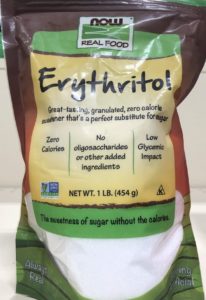 Often used in: drinks, hard candy, chocolate milk, frozen desserts, baked goods and packaged sweeteners (under the brand names Swerve, Wholesome and Z-Sweet). For example, the Swerve brand can be a sugar replacer for powdered sugar.
Often used in: drinks, hard candy, chocolate milk, frozen desserts, baked goods and packaged sweeteners (under the brand names Swerve, Wholesome and Z-Sweet). For example, the Swerve brand can be a sugar replacer for powdered sugar.
What is it: considered a sugar alcohol, but is different from artificial sweeteners. Small amounts of it are found naturally in fruits such as pears, melons and grapes (but don’t actually contain any alcohol). Virtually all of the erythritol used as food additives are produced by fermenting glucose with various yeasts. Many companies mix it with stevia leaf extract (Truvia) or monk fruit extract (Lakanto Monkfruit) to mask those other sweeteners’ unpleasant aftertastes.
Health concerns: Once considered safe by many, a new study has reported that erythritol may increase the risk of blood clots. Until more information becomes available, it is best to avoid the consumption or erythritol.
Erythritol should no longer be considered safe as a sugar substitute.
Finally, a sugar replacer considered safe!
STEVIA
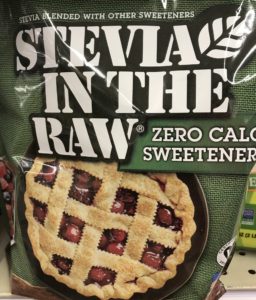 Often used in: Stevia is used in beverages, various foods and packaged sweeteners as either powder or liquid drops sold under the brand names Truvia, Pure Via and Sweet Leaf.
Often used in: Stevia is used in beverages, various foods and packaged sweeteners as either powder or liquid drops sold under the brand names Truvia, Pure Via and Sweet Leaf.
What is it: formally called Stevia rebaudiana, it is a shrub that traditionally grew in Brazil, Paraguay, and even parts of Arizona. It is now grown commercially in California, China, southeast Asia and elsewhere. Stevia leaves are about 30 times as sweet as sugar and contain sweet substances called steviol glycosides that are 200–300 times sweeter than sugar.
The food industry and many consumers have high hopes for stevia leaf extracts, as they have long been used in Japan and several other countries. One flaw, though, is that many people perceive stevia leaf and its sweet derivatives to have an unpleasant aftertaste, which companies are trying feverishly to overcome. A common practice to be aware of is Stevia is sometimes blended with erythritol and/or monk fruit.
Stevia appears safe as a sugar substitute.
Proceed with Caution:
MONK FRUIT EXTRACT
Often used in: various sugar-free foods like frozen desserts, soft drinks and packaged sweeteners. Also called swingle fruit extracts (SGFE), Luo Han Guo, Lo Han Kuo. Labels may call the ingredient monk fruit, but don’t think you’re getting any whole fruit; manufacturers use a multi-step process to extract just its intensely sweet substances called mogrosides.
Since monk fruit has been consumed in China for several hundred years and used as an herbal medicine for the past several decades, it may well be safe, although this level of processing has not actually been tested. This is why CSPI advises “CAUTION” with monk fruit extract. Plus, monk fruit is very often made with erythritol, which is another reason it is best to avoid it if possible.
Our bottom Line:
- Don’t be afraid of natural sugars! Found in fruits, vegetables and other whole foods, these naturally occurring sugars come “packaged” with a variety of vitamins, minerals, water and fiber. The result is these sugars are released slowly into the bloodstream and are absorbed differently than added sugars.
 Focus on REAL food! Since several authorities have ascertained that our bodies can handle 6-9 tsp of added sugar safely per day (for women and men respectively), we choose to use natural sugar, favoring the closest to natural forms as possible, such as pure maple syrup, honey, dates, molasses, date sugar, coconut sugar and cane sugar (or even just good old table sugar), but keep it below the above amounts. When your focus is REAL food, a little goes a long way, and it’s easy to live within these amounts.
Focus on REAL food! Since several authorities have ascertained that our bodies can handle 6-9 tsp of added sugar safely per day (for women and men respectively), we choose to use natural sugar, favoring the closest to natural forms as possible, such as pure maple syrup, honey, dates, molasses, date sugar, coconut sugar and cane sugar (or even just good old table sugar), but keep it below the above amounts. When your focus is REAL food, a little goes a long way, and it’s easy to live within these amounts.- Choices! Some people may choose Stevia for use in certain homemade cakes or cookies that could otherwise easily zoom past the recommended max sugar intake. So, depending on your goals (like managing diabetes or a hard to control sweet tooth), choosing Stevia may be a wise choice for you. But, as with all things, enjoy it with moderation…and remember, as with many things, it’s the dose that makes the poison!
As always, keep it simple and EAT REAL FOOD!
 LEARN MORE ABOUT THE NAPKIN!
LEARN MORE ABOUT THE NAPKIN!
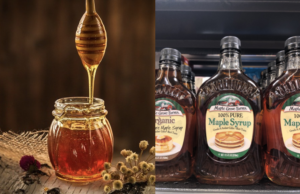
Thank you for the kind words, Gail! And yes, hail to natural sugars… and when we dial down our desire for sweets, “moderation” of what nature provides is indeed plenty! -Zonya
This was super helpful!!
Alexandria – Thank you for asking the questions about sugar substitutes and so glad this helped!
Thanks for the update on sugar substitutes. What to use and what not to use.
This was very helpful.